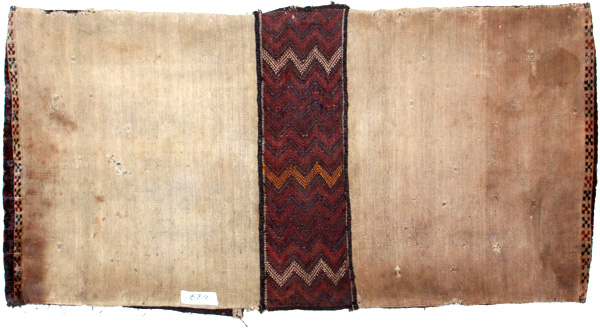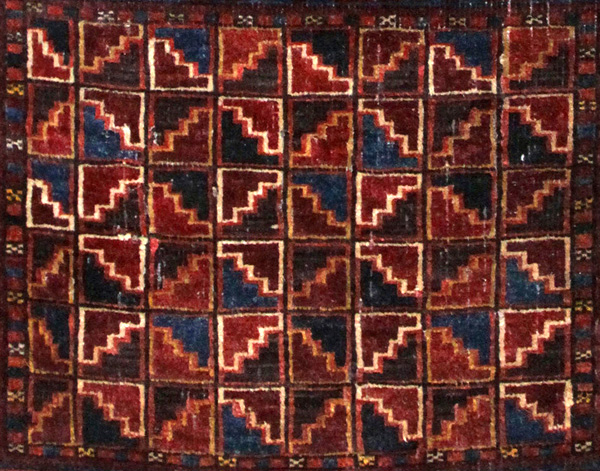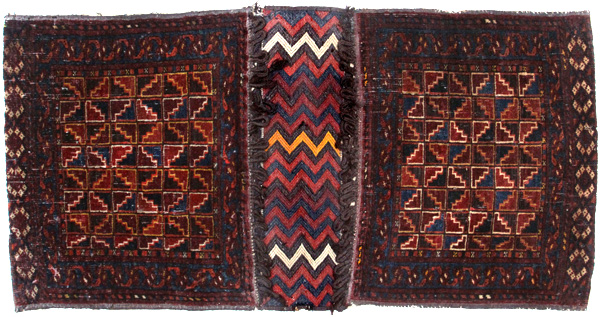< Back to Carpets
& Rugs
< Previous
Next >
Antique Baluch Khorjin - a Complete Pair of Antique Saddle Bags
***
Complete pairs of Baluch Khorjin saddle bags which could reasonably be attributed to the 19th century are very rare. Khorjins, unlike most of the indoor Baluch rugs, were usually subjected to hard use and exposed to extreme weather conditions, and that is why older examples like this beautiful and authentic pair of saddle bags, are expected to be rare - most original saddle bags which were woven for daily use have supposedly disintegrated.
אודה ואתוודה שמבין קבוצות אורגי השטיחים הנוודים שחיו במאה ה-19 ותחילת המאה ה-20 במרחב קשה הקיום שבין צפון-מזרח פרס למערב אפגניסטאן, זו המכונה בלוץ' baluch או בלוצ'י beluchi היא האהובה עלי. קראתי רבות על אי הבהירות שבהגדרת ההשתייכות השבטית של הבלוצ'ים ועל כך שמוצאם שונה מזה של השבטים הטורקמנים. הבלוצ'ים ברוכי הכשרון נאלצו לשרוד כמיעוט חלש ומפוצל תחת "חסותם" של שכנים טורקמנים חזקים כמו הטקה, היומוט, הארסרי, הסלור והסאריק ויש אומרים שלמעשה נטמעו בהם.
חוקרים גם את השפעת המוטיבים הטורקמנים על תרבות האריגה הבלוצ'ית
הייחודית והאם זה נעשה בכפייה או לא, אבל למרות השאלות הרבות שנותרו פתוחות,
איני יכול לעמוד בפני הקסם של השטיחים הכהים והמסתוריים שארגו הנשים הבלוצ'יות
המוכשרות כל כך בתנאים לא תנאים. במיוחד אני אוהב את שקי האוכף Khorjin והכריות
השימושיות Balisht שנארגו על גבי נולי אריגה קטנים ופרימיטיבים שניתן היה לפרקם תוך
כדי עבודה כאשר נאלצו לנדוד למקום המרעה הבא. פלטות הצבעים האפלות שלהן, הדגשי
נקודות הצבע הבהירות המינימליות ותחכום הביטוי האמנותי של אורגות מופלאות אלו
מרתקים.
The wonderful saturated dark colors in this beautiful original and complete pair of big Baluch Khorjin come from its natural dyes, although there are a few small dots of wool, dyed with a synthetic "hot" yellow, for example on the outer border of the right bag face as depicted in the picture below:
![]()
A few small dots of "hot" yellow
The fact that the amount of synthetically dyed wool in the faces of this Khorjin is so small, probably means that it was woven before the yellow synthetic dye became readily available and inexpensive for the Baluch weavers, and therefore a reasonable dating of this beautiful piece is the end of the 19th century. Both bags are somewhat stretched towards their bottoms, as might be expected if they had been used as containers. The backs of the bags which are flat woven, show some wear and stains near the lower corners of the bottoms, and this also suggests that they had seen utilitarian service. The kilim flat-woven bridge has a colorful zig-zag Chevron design with a sparkling yellow stripe in the middle.

The back side of the Baluch Khorjin with a Kilim connecting band in Chevron design
As with most Baluch rugs which were woven in villages in Northeastern Iran, the colors of this Khorjin are typically dark; the main border of the faces, for example, is predominant with shimmering indigo, deep blue surrounded by deep brown and red which form a snake pattern made of miniature Boteh motif pieces, enlivened with small touches of white, yellow and pale ochre. The color saturation of the indigo dyed wool is so intense that it almost appears black - you should have a look at it in full day light and see the beauty yourself.

An interleaved snake pattern border made of miniature Boteh motif pieces
And there is also the fascinating skirt design at the bottoms of the bags - each of the 6 diamond shape circles is comprised of 8 white miniature eight-point stars with dark dot in the middle. On the skirt of the left side bag face, the weaver added an extra of 3 small miniature white stars. Why? Well I wish I were there to ask her.
![]()
A diamond shape circle comprised of 8 white miniature eight-point stars, each one with a dark dot in the middle
But above all, the most interesting and uncommon feature of this pair of saddle bags is the design of the fields of the bag faces. The central part of each of the faces is a grid made of eight columns and six rows of small squares - each square is composed of 2 interlocking triangles. However, if you expected this grid to be filled with some monotonically repeating basic shape, you are taken by surprise by what seems to be a variety of shapes and by the richness of the colors and their shades. The impression is strong and tantalizing, drawing you to explore it and discover the source of the tension and dramatic effect it produces.
A careful examination reveals, that after all, there is a basic pattern that repeats itself - the 6 x 8 = 48 squares of the grid come in four varieties, each one of those gives the other three by either reflecting it about a horizontal or vertical axis or by rotating it through 180 degrees. Both columns and rows repeat, but in an alternating fashion, that is, the first, third, fifth and seventh columns from the right, are identical to each other and so are the second, fourth, sixth and eighth (the eighth column is in fact an exception, the original basic square shrunk along one of its sides to a rectangle). A similar statement applies to the rows.

Antique Baluch Saddle Bags - interlocking triangles pattern
![]()
Thus, surprisingly enough, the basic design follows a rigid symmetry, but more surprisingly, it is cleverly masqueraded! How is it done? I think that the explanation lies in the intelligent use of varying colors, the blue highlights in some of the squares and in the effect of the diagonal staircase which cuts each square, draws our attention, and keeps us within the drama.
אין ספק שהפרט המעניין ביותר בצמד שקי האוכף עתיקים אלו הוא התכנון המיוחד של תבנית המשבצות שעל פני השטיח שיוצרות את החלק החיצוני של האוכף. דוגמאות משובצות הן מוטיב די נפוץ בשטיחים שנארגו על ידי השבטים הנוודים מן המזרח ודווקא בשל כך בולטת מצוינותה האמנותית של אורגת שטיח זה, שהצליחה ליצור תבנית שריג דרמטית ועשירה המתבססת על תתי הגוונים והבוהק של המבנים המדורגים שבתוך כל משבצת. אמנית גדולה.
Note 1: Uwe Jourdan, Oriental Rugs: Volume 5 - Turkoman (1989 Example no 183 page 214) attributes a relatively similar rug to be a Yomut Khorjin from the 2nd half of the 19th century. In this reference Jourdan presents a piled double bag with unusual decoration. A compartment design made up of interlocking triangles with a diagonal zig-zag effect created by the use of color. Although apparently purely abstract, the triangle retain a bird-like appearance, which is why the design has sometimes been called the "bird triangle".
Size: 3' 10.1" x 1' 10.8" -
117
cm x 58 cm - 46.1 in x 22.8 in
Warp: Wool
Face thickness: 8 mm approx
Pile: Sheep & camel wool
Origin: Tribal groups of Afghan and Iran - Baluch
Weaving technique: Combined knotted and piled and Kilim flat
hand weaving
Age: more than 100 years old (late 19th century).
Price: Call
References:
Yomut Khorjin from the 2nd half of the 19th century - Uwe Jourdan, Oriental Rugs:
Volume 5 - Turkoman (1989) Example no 183 page 214.
Antique Baluch Bolesht (Balisht) - a Baluch Pillow
Bag
Antique Baluch Khorjin - a Saddle Bag
The Baluch
Rugs Weaving - Origin & Culture
Turkmen Rugs - Terminology, Transcription, Pronunciation, Spelling and
Nomenclature
© Dan Levy - Art Pane Home of Oriental Carpets and Rugs
< Back to Carpets
& Rugs
< Previous
Next >

